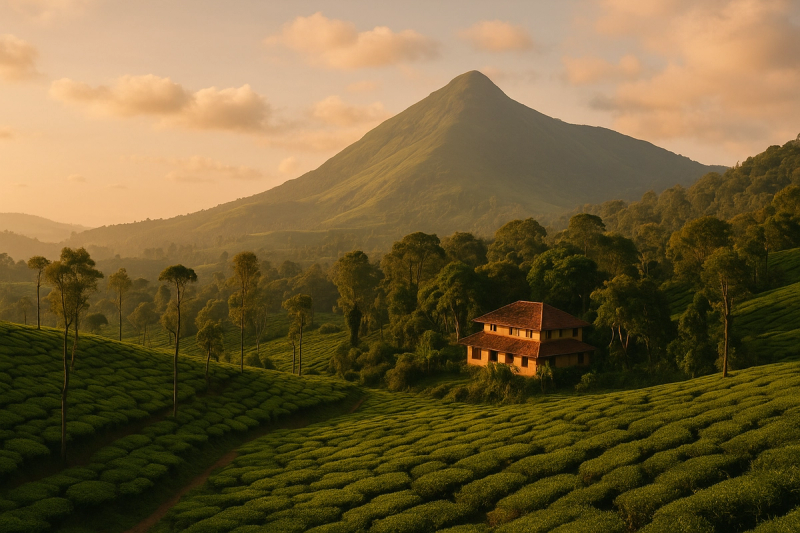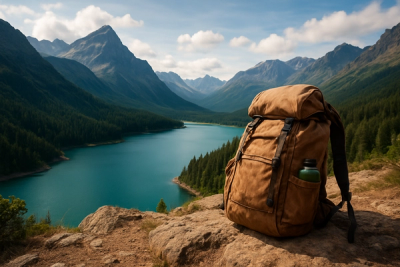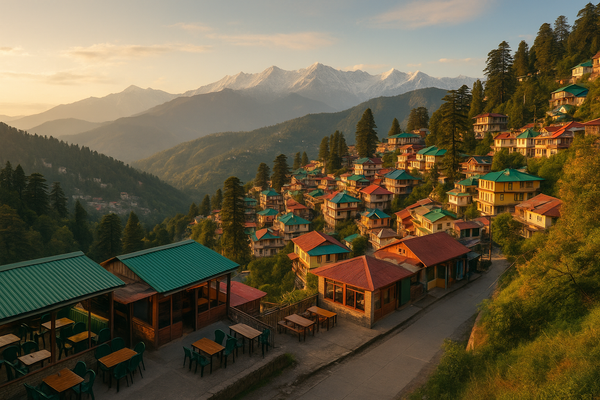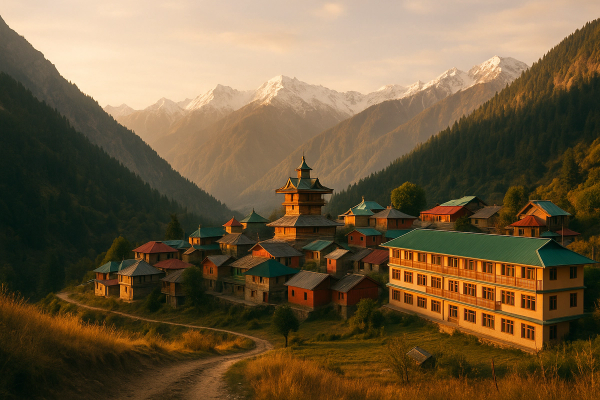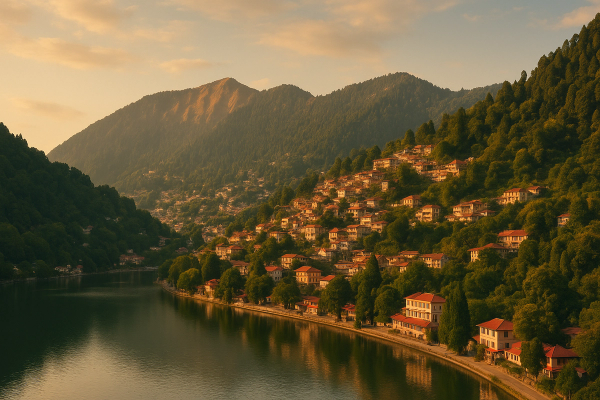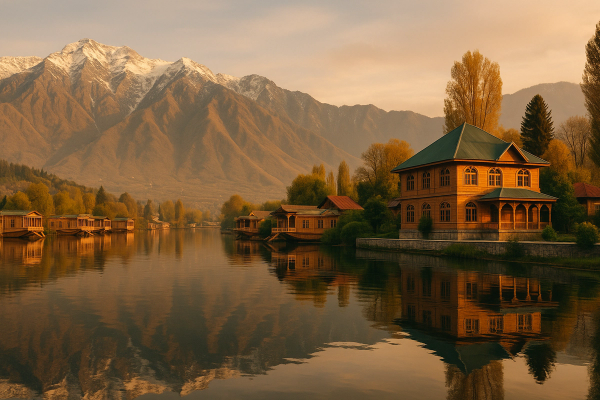Chembra Peak Trek & Offbeat Wayanad Homestays Guide — a very real, slightly messy, fully heart thing#
I’ll say it upfront — Chembra isn’t just a trek. It’s a mood. That slow, misty Wayanad feeling where tea hills roll out like a green carpet and somebody somewhere is frying pazham pori at 7 am and you can smell the banana and cardamom floating in the air. I finally did the Chembra Peak trek after putting it off for way too long, and then ended up staying in a tiny, family-run homestay near Meppadi where the aunty insisted I eat a second helping of puttu kadala because “beta, trek ke liye power chahiye”. So yeah, this is one of those posts that’s half story, half super practical info you can actually use. I’m writing it like I talk. Little imperfect. Little chatty. Local vibes only.¶
What’s the fuss about Chembra anyway?#
Short answer — it’s the highest peak in Wayanad. Tall, proud, with that heart-shaped lake you’ve seen on Instagram. The long answer — the walk itself is a lovely mix of grassland and shola forest, with views to make you feel small in the best possible way. It isn’t a technical trek, but it’s not a casual “slippers and selfie stick” stroll either. You’ll huff, you’ll puff, and you’ll grin like a fool when the fog lifts and the tea estates look like Minecraft for adults. Also, the vibe around Meppadi… I don’t know, it’s Kerala but a bit rugged, a bit younger. Cafes, chai kadais, jeeps going tuk-tuk on those bends. I liked it more than the postcardy bits of Munnar, honestly.¶
First, the practical stuff nobody tells you clearly#
Permits are mandatory for Chembra. You don’t just rock up and hike. The trail is managed by the Kerala Forest Department, and there are daily limits. On weekends and holidays it sells out proper, like movie first day first show. You can usually book online on the Kerala Forest Department’s ecotourism portal or at the base counter near Meppadi, but booking ahead is way safer. Entry typically opens in the morning and last entry is early afternoon, after which they just won’t let you start. Plastic is strictly banned, and they do a bag check. They’ll note the number of water bottles you carry and make you bring them back. Guides are either mandatory or strongly recommended depending on the day’s rules and weather, but practically, they attach a guide to groups for safety. Also, sunrise treks aren’t allowed. Don’t argue with the staff about it, they’ve heard every line.¶
How to reach Meppadi and the Chembra base without losing your mind#
If you’re coming from Bengaluru, the classic route is via Mysuru and Gundlupet to Sultan Bathery, then Kalpetta, then Meppadi. The other common entry is from Kozhikode side over the Thamarassery ghat — those 9 hairpins are iconic. From Kalpetta to Meppadi is like 20–30 minutes depending on traffic and tea-photo stops. There are KSRTC buses that drop you in Meppadi town, and from there you can catch an auto or a jeep to the forest checkpost at Chembra’s base road. If you’re flying, Kozhikode airport is the closest, and Kannur is also doable these days. Monsoon months can mean landslides on ghat sections, so yes, keep an eye on district alerts. Just basic common sense, you know.¶
Latest on rules, timings, and closures (the reality check bit)#
- Daily slots are limited. Weekends get snapped up. If you’re planning a long weekend or festive period, book online in advance on the official ecotourism portal. Carry original ID. Screenshot the booking, network can go cranky.
- Timings change with season and weather. Typically mornings to early afternoon. They won’t allow late starts because folks get stuck returning in the mist.
- Monsoon closures happen. Even when open, it’s leech city June to August. If there’s heavy rain or forest fire risk in summer, they’ll pause entry. It’s not personal.
- Plastic ban is serious. They will check and count. Fines are a thing now.
- Drones are a no. So is loud music. Please, no Bluetooth speaker party on the ridge. This is not Goa beach.
- Full-summit access is often restricted. Most days, you’re allowed till the heart-shaped lake area. The lake is called Hridaya Saras. The summit beyond may be closed for habitat reasons. Don’t force it, don’t bribe, don’t do jugaad. It risks the trek being shut for everyone.¶
Booking the Chembra trek step by step, like a normal person would actually do it#
- Check the Kerala Forest Department eco-tourism website for Chembra and see if slots are open for your date. If not, try a weekday. Way less crowd.
- Book your slot and keep the payment confirmation. Typically you pay a per-person fee, plus separate camera or parking charges on the spot.
- On the trek day, reach early. I was at the checkpost by around 7:45 am and honestly that felt right. Later means more sun and more rush.
- Plastic check, quick briefing, guide allocation. Keep your bottles minimal and reusable.
- Do the climb in a chill pace. There are a few obvious breaks where everyone rests. The heart lake comes a little later than you think, so don’t keep asking every person coming down, “Bhai kitna door?” Just… walk.
Fees and exact timings can change, and in early 2025, they were still tweaking online vs counter balance on busy days. So best is to check the official portal or call DTPC Wayanad. Don’t rely on 4-year-old blog posts for this part. Things update.¶
So how tough is it really? The trail and what it actually feels like#
It’s moderate. Not brutal. Most able-bodied folks can do it with small breaks. The start is gentle through estate-like patches, and then the grassland opens up with clean views. Underfoot it’s a mix of mud, stone, and some slippery bits if it rained the night before. One-way time to the heart lake is roughly 1.5 to 2 hours depending on fitness and crowd. Coming down is faster, but take it easy because loose gravel likes to do comedy. There are no food stalls on the trail, and there’s no shade for long sections, so cap and water are not optional. Also, if the mist rolls in, the atmosphere gets dreamy but the inclination kinda pops out of nowhere and your lungs go, “Arre boss.” I loved that drama though.¶
My day was moody. Clouds doing peekaboo, sun popping out like someone switched on a torch, wind hissing across the grass. Our guide, Sasi ettan, was that classic calm Malayali uncle. Pointed out wagging-tailed wagtails and a patch of Kurinji that won’t bloom this season but, you know, we all still got excited because it’s Kurinji. When the heart-shaped lake finally appeared, surprisingly small and seriously cute, there was this sudden hush. Even the loud groups went quiet for a minute. I’m not kidding. I sat on a rock, ate a warm banana from my bag, and watched the fog walk across the water like a cat. Cheesy. But true.¶
What to carry without overpacking like a full-on expedition#
- 1–2 reusable water bottles. Electrolyte sachet helps if you cramp up easily
- A light rain jacket or poncho if there’s even a rumour of rain
- Cap, sunglasses, sunscreen even if it looks cloudy in the morning
- Trail shoes or sports shoes with grip. Not brand new ones, break them in first
- Quick snack: bananas, chikkis, groundnut bar, bread omelette from the roadside shop if you’re me
- Small first aid: band-aid, pain spray, any personal meds
- If it’s monsoon or just after, leech socks or at least salt and calm vibes
Where I stayed: offbeat homestays that actually feel like Wayanad#
Wayanad has hotels, sure, but the soul sits inside those small homestays tucked in tea or arecanut or pepper farms. I stayed near Meppadi in a family house where breakfast was on banana leaf and the wifi worked only if the rain gods were in the mood. Which is exactly how I like it. Prices in Wayanad for homestays, very roughly: budget rooms from 1000–2500 a night, nice mid-range cottages 3000–6000, and then estate villas or treehouses can go 7000–15000 and above during peak season. Weekends are pricier, obviously. If you want quiet and bird calls instead of a pool and karaoke, pick Meppadi, Pozhuthana, or the lanes around Vellarimala. For lake vibes and sunset, Thariyode or Padinjarathara near Banasura Sagar is lovely. Vythiri is popular, a bit busier. Sultan Bathery side is practical if you’re also doing Edakkal Caves or Muthanga safari.¶
Some offbeat stay zones I genuinely liked (not sponsored chill)#
- Meppadi tea estate belt: Simple rooms inside old planters’ homes, mist hugging the verandah at 6 am, tea that tastes like it has a backstory. Easy access to Chembra and Soochipara.
- Pozhuthana and Kunnathidavaka: River-adjacent homestays with arecanut, pepper vines everywhere. Nights are cricket-sound heaven. Chefs here do insane fish curry if you ask nicely in advance.
- Thariyode/Padinjarathara: Cute cottages with Banasura hills view. Evening breeze is chef’s kiss. Great base if you want to do a Banasura dam morning walk or kayak.
- Tholpetty side: For wildlife nerds. Rustic, a little far from Chembra, but mornings feel like Jurassic Park minus the dinosaurs.
Booking tip: many homestays prefer WhatsApp with 20–50% advance via UPI. Read the latest reviews, ask for actual photos, and triple-check if hot water and power backup exist. Don’t assume.¶
Food, chai, and that one beef fry I’m still thinking about#
Kerala food in Wayanad hits different. Roadside chai shops doing magical pazham pori and ethakka appam, local mess places serving Kerala meals on banana leaf with red rice that will make you nap. Around Kalpetta and Meppadi town you’ll find tiny joints doing porotta and beef or chicken curry, kappa with meen curry, and chaattichoru lunch boxes that trekkers love. I had a meen pollichathu in a no-name shop near Meppadi bus stand that was smoky, limey, perfect. If you don’t eat meat, no stress — avial, thoran, sambar, rasam, everything is top tier. Ask your homestay for dinner. When aunty cooks, life is basically solved.¶
My day on the trail, in messy little moments#
I started late because I got distracted by a tea factory view point, classic me. Almost missed the early slot, but the guard let us through with a gentle lecture. The first 20 minutes felt easy. Then the angle increased and my city lungs went, “bro why.” Met a college gang from Kozhikode blasting Malayalam hits on a mini speaker and, no surprise, the guide immediately told them volume low. Good. The heart lake segment is where the crowd clusters for photos. Don’t step into the water. It’s not a swimming pool and the ecosystem is delicate. On the way down, a cloud moved like a slow train across the ridge and suddenly visibility dropped to like 10 meters. We all laughed, shuffled in a line, reached the jeep point, and then I inhaled a lemon soda like it was oxygen. Peak happiness.¶
Other things to do around Chembra when your legs are like, can we not?#
- Soochipara Waterfalls: Close to Meppadi. Steps down to the fall, decent crowd, safe spots marked. Post-monsoon is roaring. Wear good grip. Morning is best.
- 900 Kandi Glass Bridge: Very influencer-y but also kinda fun if you like off-road jeep rides through forest patches. Costs vary by operator. Good for a half-day chill with friends.
- Edakkal Caves: Rock art that will blow your mind a little. Time slots, a small climb, and some queues. Worth it. Closed on Mondays typically.
- Banasura Sagar: Do a sunrise or sunset walk, boating when open, and random tea stalls that will tell you their family history if you smile.
- Kuruva Dweep: Riverine island experience with limited daily tickets and seasonal opening. Check online bookings and water level updates.
- Tholpetty or Muthanga Safari: Book at the gate for early morning or evening. It’s a forest, not a zoo, so wildlife sightings are luck. Please don’t demand tigers from the driver. He’ll also shrug.¶
Best time to visit, rains, and the leech situation nobody loves#
October to February is peak pleasant. Green, clear-ish skies, cool evenings. March to May gets warm during the day but mornings are still nice. June to August is full monsoon mode. Wayanad in rain is magic, but treks can close, landslides can happen, and leeches are like Netflix — everywhere. If you go in monsoon, do short hikes, carry leech socks, and don’t be dramatic if one finds you. They don’t care about you personally. They just… do leech things. Also, even in the best months, Wayanad mornings can be misted out. So your mega view might be 30 minutes delayed. Patience pays.¶
Money matters: rough costs so you can plan without spreadsheet headache#
- Chembra permit fees are per person plus camera and parking fees if applicable. Expect a few hundred rupees per person range, not thousands. Exact amounts change.
- Homestays: 1000–2500 for budget, 3000–6000 mid-range, 7000+ for fancy or treehouse style. Weekends and holidays spike.
- Food: Local meals 100–250, snacks 20–60, decent dinner 150–350 per head if you avoid fancy restaurants. Estate resorts obviously pricier.
- Transport: Autos are fair in towns. Off-road jeeps for adventure points cost more, negotiate but don’t lowball to pain. Petrol is… yeah, petrol.
- Tickets for waterfalls, caves, glass bridge — small entry fees and parking. Carry change or UPI. Everyone takes UPI now, which is honestly the best thing to happen to travel.¶
Respect the place: small do’s and please-don’ts#
- Don’t litter. Carry back plastic, snack wrappers, cigarette butts, all of it. Forest staff actually checks bottles count at Chembra base when you return
- Wear decent clothes if you’re going through villages. Kerala is chill but respectful dressing always sits well with locals
- No blasting music. Nature already has a soundtrack, and it’s better than your playlist, trust me
- Ask before pointing cameras at people. Plantation workers aren’t props for your content
- Support local — buy spices, honey, bamboo rice from verified cooperatives or your homestay host’s network, not random overpriced traps
A simple 2.5-day plan that actually works and doesn’t feel rushed#
Day 1: Reach Kalpetta/Meppadi by noon. Check into a homestay. Late lunch. Evening walk through tea lanes. If there’s time, quick run to Kanthanpara or Pookode Lake for a gentle start. Sleep early, I’m serious.
Day 2: Chembra day. Early breakfast. Be at the checkpost as gates open. Do the trek, spend time at heart lake, back by early afternoon. Lunch at a local mess. Nap. Sunset at Banasura or just sit on the verandah counting crickets. If you’ve energy, a chai-drive to a viewpoint near Meppadi.
Day 3: Either Soochipara or Edakkal, depending on your mood. Brunch, pack up, and leave before ghat traffic builds. Or do nothing and miss your bus because verandah naps are superior. Both are valid life choices.¶
Random tips I wish someone had told me, but maybe they did and I ignored#
- Start the trek with a slow pace. If you sprint initially, you’ll hate yourself in 20 minutes
- Carry a small towel. You will sweat. A lot. Wayanad is cool but humidity has opinions
- Don’t wear jeans. They get heavy and weird on climbs. Light trek pants or track pants are your friends
- If you’re photo-obsessed, do early weekday. Less crowd, better frames, less editing of strangers from your reels
- Cash a little, UPI mostly. Network drops in pockets, so screenshot QR if your host shared it earlier
- Phone torch helps on the way back if clouds bring early dim light. Don’t rely on charge-2% panic mode
Is it safe? Current vibe and sensible precautions#
Wayanad is one of the safer hill regions to travel in, especially if you stick to marked routes and daylight driving on ghats. The forest department is strict where needed, which I appreciate. Avoid night hikes. Monsoon roads can be slippery, so go slow and ignore honking Champs behind you. Wild elephants are real in Wayanad. If you see road signs warning of crossings, go careful, don’t stop for photos, don’t crowd. Safari zones are not for walking. Also, the usual travel sense — tell your homestay your plan if you’re going off-grid, carry a charged powerbank, and don’t do illegal bonfires because Instagram made them look cool. It’s 2025 now, we’ve all seen what happens when spots get overrun and rules get ignored.¶
A tiny love letter to Wayanad’s homestay culture#
There’s something about waking up to the smell of fresh coconut scraping and a pressure cooker singing. Homestays in Wayanad turned my trip from a checklist to a conversation. One evening, my host’s father told me stories about the old tea routes and how the town changed after the new airport got popular. Another night, I sat with two travelers from Kochi on plastic chairs in a drizzle, passing around a plate of hot tapioca chips, arguing which waterfall is the “real” one. You don’t get that in a polished resort. And ya, resort pools are great, but a backyard full of pepper vines and a dog named Chinnu who escorts you to the gate every time you leave — that’s the stuff I’ll remember.¶
If you treat Wayanad like a postcard, it’ll pose. If you treat it like a friend, it’ll talk back. Chembra is the hello. The homestay is the conversation.
Quick FAQ that’s not boring#
- Can beginners do Chembra? Yes, with breaks and proper shoes. Kids above 8–10 usually do fine. Seniors should check with the forest folks and their own stamina.
- Are there toilets on the trail? Basic facilities near the start point. Not on the ridge. Plan accordingly.
- Is sunrise allowed? Nope. Gates open morning hours, but not predawn. Best light is often mid-morning when mist lifts.
- Can we camp at Chembra? No camping. Day hike only.
- What about full summit? Often restricted. Expect to be allowed till heart lake. Happy surprises sometimes, but don’t count on it.
- Network? Jio and Airtel work in towns. On the trail it’s hit or miss. Which is secretly nice.
- Solo traveler friendly? 100%. Kerala is generally safe. Homestays will fuss over you like family.¶
Wrap up — would I go back? Uh, obviously#
Chembra gave me sore calves, a camera roll full of green, and a new favorite place to drink chai slowly. Wayanad’s offbeat homestays made me feel like I was visiting cousins I actually like. It’s the mix, na — a disciplined, well-managed trek and the deeply warm, unhurried home life in the evenings. If you’re on the fence, just go. Book your permits, pack light, eat local, leave no trash, tip your hosts, and let the mist do its thing. And if you want more travel stories and desi-style guides that don’t read like a manual, I keep saving ideas on AllBlogs.in — worth a browse when you’re planning the next long weekend.¶

